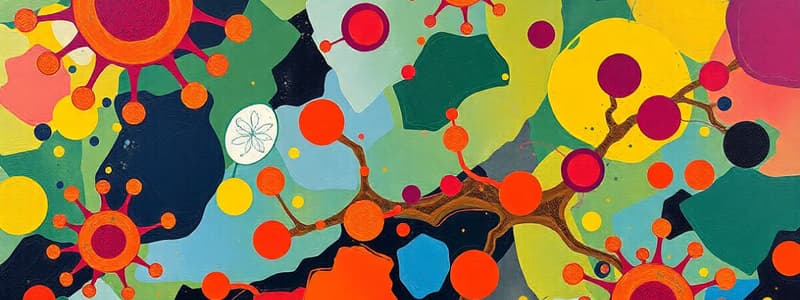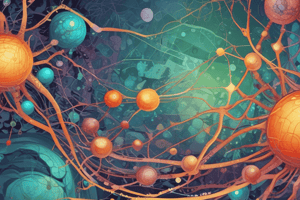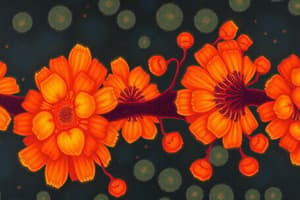Podcast
Questions and Answers
What initiates the alternative pathway of the complement system?
What initiates the alternative pathway of the complement system?
- Hydrolysis of C3 in liquid phase (correct)
- Stabilization of C5 component
- Binding of C3 to microbial surfaces
- Activation by Factor D
What happens to C3b when there is no infection present?
What happens to C3b when there is no infection present?
- It dismutes into an inactive component (correct)
- It forms a C5 convertase complex
- It gets stabilized and binds Factor B
- It binds to microbial surfaces
Which factor is cleaved by Factor D in the alternative pathway?
Which factor is cleaved by Factor D in the alternative pathway?
- C5
- Factor B (correct)
- Ba
- C2
Which component prolongs the life of the C3bBb convertase in the alternative pathway?
Which component prolongs the life of the C3bBb convertase in the alternative pathway?
What is the primary role of the Bb fragment in the alternative pathway?
What is the primary role of the Bb fragment in the alternative pathway?
In the context of the alternative pathway, how is Factor D characterized?
In the context of the alternative pathway, how is Factor D characterized?
What happens to the C3bBb complex after it forms the C5 convertase?
What happens to the C3bBb complex after it forms the C5 convertase?
Which component is described as made by neutrophils and stored in secondary granules?
Which component is described as made by neutrophils and stored in secondary granules?
What is the primary role of C1q in the classical pathway of the complement cascade?
What is the primary role of C1q in the classical pathway of the complement cascade?
Which two antibodies need to bind to C1q for its activation to occur in the classical pathway?
Which two antibodies need to bind to C1q for its activation to occur in the classical pathway?
What does the C3 convertase (C4b2a) specifically act on in the complement cascade?
What does the C3 convertase (C4b2a) specifically act on in the complement cascade?
How does the cleavage of C4 contribute to the complement cascade?
How does the cleavage of C4 contribute to the complement cascade?
What is the consequence of aspecific binding of antibodies to C1q?
What is the consequence of aspecific binding of antibodies to C1q?
Which component is NOT part of the initial cleavage in the complement cascade as initiated by C1q?
Which component is NOT part of the initial cleavage in the complement cascade as initiated by C1q?
What characteristic structure does C1q possess that is crucial for its function?
What characteristic structure does C1q possess that is crucial for its function?
What is the main outcome of the complement cascade on the pathogen?
What is the main outcome of the complement cascade on the pathogen?
What role does C3b play in the removal of immunocomplexes?
What role does C3b play in the removal of immunocomplexes?
Which condition results from the absence of C1 inhibitor (C1 INH)?
Which condition results from the absence of C1 inhibitor (C1 INH)?
What is the primary function of the C1 inhibitor (C1 INH)?
What is the primary function of the C1 inhibitor (C1 INH)?
How do immunocomplexes pose a risk in the complement system?
How do immunocomplexes pose a risk in the complement system?
Which receptor acts as a co-receptor for B-Cells and binds to C3b?
Which receptor acts as a co-receptor for B-Cells and binds to C3b?
What type of molecules do some receptors function as to aid leukocyte activity?
What type of molecules do some receptors function as to aid leukocyte activity?
What is the implication of an increase in C2a concentration in serum?
What is the implication of an increase in C2a concentration in serum?
Which component of the complement system mimics C4 to inhibit C1 activation?
Which component of the complement system mimics C4 to inhibit C1 activation?
What is the primary function of C5b in the complement system?
What is the primary function of C5b in the complement system?
Which subclass of immunoglobulin is noted for its high potency in activating the classic pathway of the complement system?
Which subclass of immunoglobulin is noted for its high potency in activating the classic pathway of the complement system?
What happens when Mannose Binding Protein (MBP) interacts with microbial sugars?
What happens when Mannose Binding Protein (MBP) interacts with microbial sugars?
What is a defining characteristic of Ficolins compared to Mannose Binding Protein (MBP)?
What is a defining characteristic of Ficolins compared to Mannose Binding Protein (MBP)?
What is the role of the C4b2a complex in the complement pathway?
What is the role of the C4b2a complex in the complement pathway?
How many monomers make up the Mannose Binding Protein (MBP)?
How many monomers make up the Mannose Binding Protein (MBP)?
Which of the following components generates over 1000 C3b molecules through a single C3 convertase?
Which of the following components generates over 1000 C3b molecules through a single C3 convertase?
What structural feature distinguishes Ficolins from other complement-activating proteins?
What structural feature distinguishes Ficolins from other complement-activating proteins?
What is the main role of MHC class I and class II molecules?
What is the main role of MHC class I and class II molecules?
Which characteristic is NOT true about the MHC molecules?
Which characteristic is NOT true about the MHC molecules?
What distinguishes non-classical MHC molecules from classical ones?
What distinguishes non-classical MHC molecules from classical ones?
What does the term 'polymorphic' refer to in the context of MHC genes?
What does the term 'polymorphic' refer to in the context of MHC genes?
In terms of inheritance, how are MHC genes expressed?
In terms of inheritance, how are MHC genes expressed?
Which of the following is NOT a class of MHC molecules?
Which of the following is NOT a class of MHC molecules?
Which statement about MHC molecules is incorrect?
Which statement about MHC molecules is incorrect?
What type of mutation can contribute to the polymorphism seen in MHC genes?
What type of mutation can contribute to the polymorphism seen in MHC genes?
What is a characteristic feature of the molecules that are part of the non-classical HLA class I group?
What is a characteristic feature of the molecules that are part of the non-classical HLA class I group?
Which role do ULBP molecules primarily play in the immune response?
Which role do ULBP molecules primarily play in the immune response?
What distinguishes the C1 complex from classical HLA class I molecules?
What distinguishes the C1 complex from classical HLA class I molecules?
How does the neonatal Fc receptor (FCRN) function in the immune system?
How does the neonatal Fc receptor (FCRN) function in the immune system?
Which cells express ULBP proteins that can be recognized by NK cells?
Which cells express ULBP proteins that can be recognized by NK cells?
What structure characterizes HLA class II molecules?
What structure characterizes HLA class II molecules?
In what way do non-classical HLA molecules influence T cell activity?
In what way do non-classical HLA molecules influence T cell activity?
What is the primary role of the ZAG protein in relation to the immune response?
What is the primary role of the ZAG protein in relation to the immune response?
Flashcards
Complement Activation Cascade
Complement Activation Cascade
A series of protein activations that leads to pathogen destruction, limited by control proteins.
Complement Control Proteins
Complement Control Proteins
Proteins that regulate the activation cascade, preventing excessive or widespread activation.
C1q
C1q
A component of the classical complement pathway; binds antibodies to initiate the cascade.
C1q structure
C1q structure
Signup and view all the flashcards
C1r and C1s
C1r and C1s
Signup and view all the flashcards
C4 and C2
C4 and C2
Signup and view all the flashcards
C4b
C4b
Signup and view all the flashcards
C2a
C2a
Signup and view all the flashcards
C3 convertase
C3 convertase
Signup and view all the flashcards
C3 cleavage products
C3 cleavage products
Signup and view all the flashcards
Complement Cascade Goal
Complement Cascade Goal
Signup and view all the flashcards
Complement System C3
Complement System C3
Signup and view all the flashcards
C3 convertase
C3 convertase
Signup and view all the flashcards
C5 convertase
C5 convertase
Signup and view all the flashcards
Membrane Attack Complex (MAC)
Membrane Attack Complex (MAC)
Signup and view all the flashcards
Classical Pathway
Classical Pathway
Signup and view all the flashcards
Lectin Pathway
Lectin Pathway
Signup and view all the flashcards
Mannose-Binding Lectin (MBP)
Mannose-Binding Lectin (MBP)
Signup and view all the flashcards
Ficolins
Ficolins
Signup and view all the flashcards
Immunocomplex Removal
Immunocomplex Removal
Signup and view all the flashcards
C3b Binding
C3b Binding
Signup and view all the flashcards
Complement Regulation
Complement Regulation
Signup and view all the flashcards
C1 Inhibitor (C1 INH)
C1 Inhibitor (C1 INH)
Signup and view all the flashcards
Hereditary Angioedema
Hereditary Angioedema
Signup and view all the flashcards
Alternative Pathway
Alternative Pathway
Signup and view all the flashcards
C3 Hydrolysis
C3 Hydrolysis
Signup and view all the flashcards
C3b Stabilization
C3b Stabilization
Signup and view all the flashcards
Factor B
Factor B
Signup and view all the flashcards
Factor D
Factor D
Signup and view all the flashcards
Bb-C3b complex
Bb-C3b complex
Signup and view all the flashcards
Properdin
Properdin
Signup and view all the flashcards
C5 convertase
C5 convertase
Signup and view all the flashcards
MHC Molecules
MHC Molecules
Signup and view all the flashcards
MHC Classes
MHC Classes
Signup and view all the flashcards
Non-classical MHC
Non-classical MHC
Signup and view all the flashcards
MHC Locus
MHC Locus
Signup and view all the flashcards
Polygenic
Polygenic
Signup and view all the flashcards
Polymorphic
Polymorphic
Signup and view all the flashcards
Codominant
Codominant
Signup and view all the flashcards
HLA
HLA
Signup and view all the flashcards
Antigen Presentation
Antigen Presentation
Signup and view all the flashcards
Non-classical HLA class I molecules
Non-classical HLA class I molecules
Signup and view all the flashcards
Immune response activation (non-classical HLA class I)
Immune response activation (non-classical HLA class I)
Signup and view all the flashcards
CD1 complex function
CD1 complex function
Signup and view all the flashcards
FCRn function
FCRn function
Signup and view all the flashcards
C1 complex composition
C1 complex composition
Signup and view all the flashcards
C1 activation pathway
C1 activation pathway
Signup and view all the flashcards
HLA Class II molecules structure
HLA Class II molecules structure
Signup and view all the flashcards
Study Notes
Lesson 4 - Immunology
- Ligands activate TRADD or FADD domains, which are dead domains in FAS and TNF receptor families.
- Molecules bind to cytosolic tails of receptors, activating caspases.
Summary of Receptors
- Homodimer Receptors: G-CSF is the only homodimer receptor.
- β Common Chain: The β chain is the same across all receptors. The α chain is specific.
- γ Common Chain: The γ chain is identical across receptors; α and β chains vary. This chain is common for many Interleukins (ILs), allowing different functions.
- Specific Receptor Examples: G-CSF, IL-3, IL-5, IL-2, IL-4, IL-6, LIF, GM-CSF, IL-7, IL-9, IL-15, LIF and IL-6 receptors (heterodimers). The specific chain of the receptor recognizes and binds the cytokine, while the transduction chain is called gp130.
- γ-Chain Mutation: Mutations or absence of the γ chain can lead to severe combined immunodeficiencies.
IL2 Receptors
- Resting Lymphocytes: Require a higher concentration of IL-2 to bind the receptor initially (lower affinity).
- Activated Lymphocytes: Produce the α chain, increasing IL-2 affinity, requiring less IL-2. This creates a competitive advantage inside lymphoid tissue.
- IL-2 Functions: Activation and proliferation of T, B, and NK cells; maturation and activation of Th2, B cells, and mast cells.
Cytokine Receptor Functions
- Several functions depending on the receptor. Some ligands induce calcium release and MAPK pathway activation.
- Cytokines can induce SOCS (suppressor of cytokine signaling), which can stop JAK activation, ubiquitinate/degrade STATs, or stop cytokine expression.
Chemokines
- A family of small cytokines characterized by chemotaxis (movement in response to chemical stimuli), directing immune cell recruitment to sites of infection.
- There are 4 families (alpha, beta, 2 other families with one member each).
Complement System
-
The complement system was first identified by Bordet early in the 20th century, identifying the serum's ability to kill bacteria.
-
It involves 30+ blood proteins in a cascade sequence, triggered by different pathways:
- Classical Pathway: Activated by changes in IgM and IgG antibodies.
- Lectin Pathway: Activated by microbial sugars, like mannose.
- Alternative Pathway: A spontaneous pathway triggered by microbial surfaces.
-
Complement proteins are sequentially activated by cleavage/activation of the next inactive protease in a cascade. Products of complement activation promote inflammation and pathogen destruction via lysis.
-
Regulation: Proteins control the pathways to prevent uncontrolled activation.
-
Functional Meaning: Cell killing, opsonization, inflammation, and removal of immune complexes.
Studying That Suits You
Use AI to generate personalized quizzes and flashcards to suit your learning preferences.




